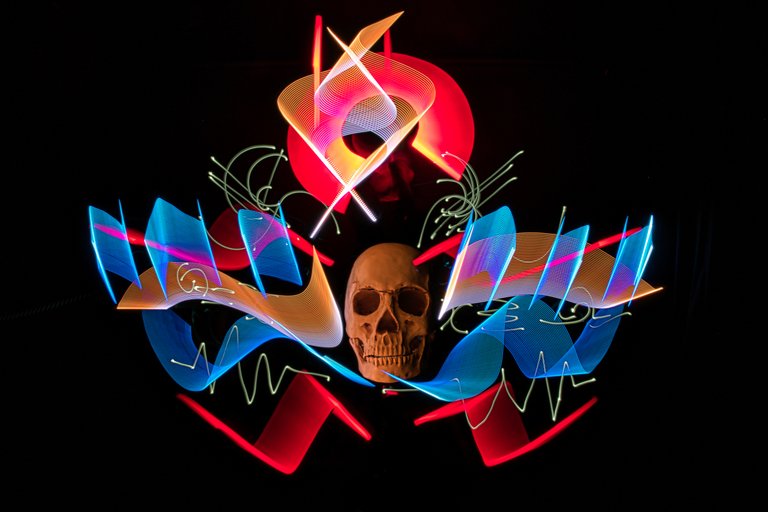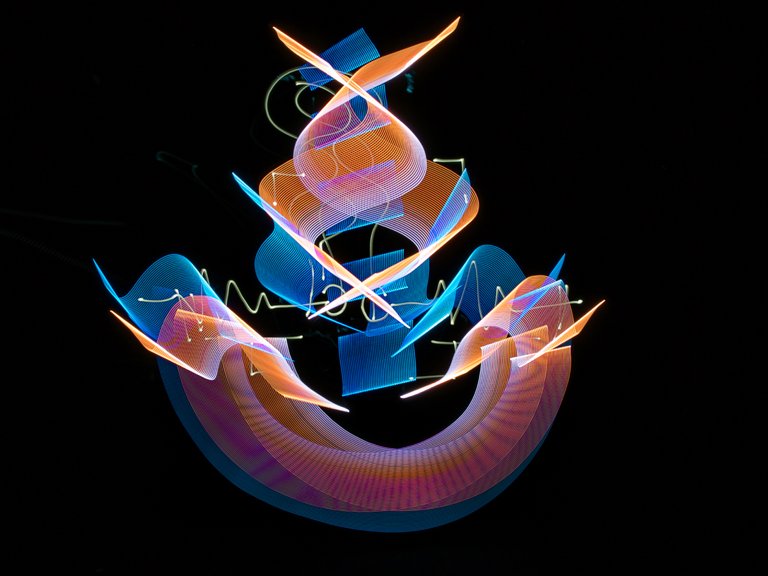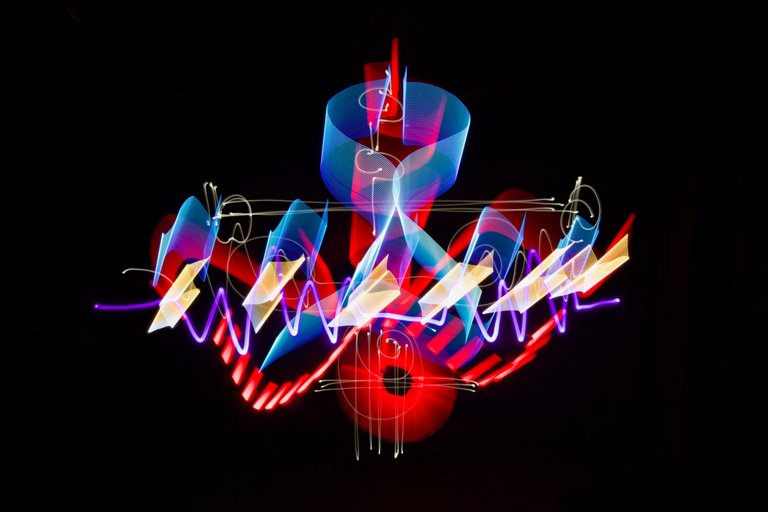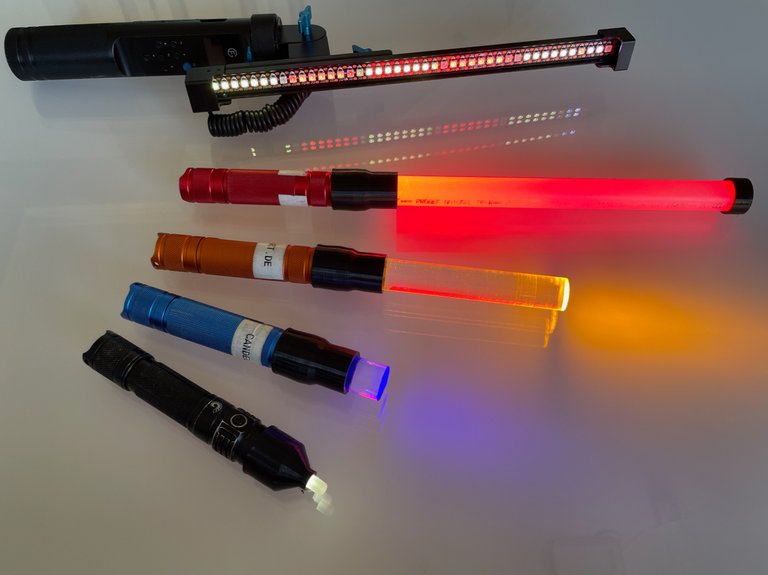Hello HIVEs!
Last night I tried my hand at the supreme discipline of light painting, calligraphy. I've been meaning to practise this for a long time. Unfortunately, something always got in the way. Most recently, the calligraphy tool refused to work after an update of the program on the Arduino installed there. The old program wouldn't run on this tool either. In desperation, I modified a 42 LED pixel stick. I dismantled the diffuser for this. I had purchased the tool years ago from FOTORGEAR. It is not ideally suited for this purpose as it has an illuminated display and the operation via the closely spaced buttons is not unproblematic. I would like to show you some of my exercises below.
Heute Nacht probierte ich mich in der Königsdisziplin des Lightpaintings, die Kalligrafie. Schon lange hatte ich vor, mich darin zu üben. Leider kam immer etwas dazwischen. Zuletzt verweigerte das Kalligrafie-Tool seinen Dienst nach einem Update des Programms auf dem dort verbauten Arduino. Auch das alte Programm wollte danach nicht mehr auf diesem Tool laufen. In meiner Verzweiflung modifizierte ich einen 42 LED Pixelstick. Dafür demontierte ich den Diffusor. Das Tool hatte ich vor Jahren bei FOTORGEAR erworben. Es ist nicht optimal für diesen Zweck geeignet, da es über ein beleuchtetes Display verfügt und die Bedienung über die eng beieinander liegenden Taster nicht unproblematisch ist. Nachfolgend möchte ich euch einige meiner Übungen zeigen.

Olympus E-M1MarkII
OLYMPUS M.12-40mm F2.8
ISO64, 12mm, ƒ16, 2,5s (LiveComposite)
Why do I describe calligraphy as the supreme discipline? Because it requires maximum concentration. Both spatial thinking and symmetry are required here. Composition, color selection and light intensity must be coordinated. It really is a challenge. The cover picture is the first interim result after 3 hours of preparation. I took this picture with an Olympus in LiveComposite mode. This has the advantage that I can follow the image composition live on the monitor. I found this very helpful for practicing the coordination of movements. As always, I will show the tools I used at the end of my article.
Warum beschreibe ich die Kalligrafie als Königsdisziplin? Weil es hier auf höchste Konzentration ankommt. Sowohl das räumliche Denken, als auch die Symmetrie wird hier gefordert. Komposition, Farbwahl, Lichtintensität müssen abgestimmt werden. Es ist wirklich eine Herausforderung. Das Titelbild ist das erste Zwischenergebnis nach 3 Stunden Vorbereitung. Dieses Bild nahm ich mit einer Olympus im LiveComposite- Mode auf. Das hat den Vorteil, dass ich den Bildaufbau live am Monitor mitverfolgen kann. Zur Übung der Koordination der Bewegungen fand ich das sehr hilfreich. Die eingesetzten Tools zeige ich, wie immer, am Schluss meines Beitrages.

Olympus E-M1MarkII
OLYMPUS M.12-40mm F2.8
ISO64, 12mm, ƒ16, 2,5s (LiveComposite)
Due to a lack of models, "Freddy" my skull had to be used for this shoot. He has the positive quality of being very calm, patient and can hold still for hours.
Together with some calligraphy, the end result looks like rocker patches on a cowl. In the picture above I tried to add some background to the picture. Unfortunately, that didn't work out so well.
In Ermangelung an Modellen musste "Freddy" mein Totenkopf für dieses Shooting herhalten. Er hat die positive Eigenschaft sehr ruhig, geduldig zu sein und kann stundenlang still halten. Zusammen mit einer Kalligrafie sieht das Endergebnis wie Rocker patches auf einer Kutte aus. Auf dem Bild oben hatte ich versucht noch etwas Hintergrund ins Bild zu bringen. Das hat leider noch nicht so gut geklappt.

Olympus E-M1MarkII
OLYMPUS M.12-40mm F2.8
ISO64, 12mm, ƒ16, 2,5s (LiveComposite)
I fitted Freddy with an Arca-Swiss quick-release plate. This makes it easy to mount and align the skull on a tripod in front of the camera.
First I exposed Freddy with the scanner. Then I used the pixelstick with two pre-selected colors and moved him in an S-shape through the background. For orientation, I stuck a dot in the middle of the set with self-luminous adhesive tape. Now it's important to move to the right and left in equal steps and to perform the light figures as identically as possible. I haven't managed that yet. But the challenging exercises have a meditative quality and I enjoy them.
Freddy habe ich mit einer Arca-Swiss Schnellwechselplatte ausgestattet. So kann man den Schädel problemlos auf einem Stativ vor der Kamera montieren und ausrichten. Zuerst belichtete ich Freddy mit dem Scanner. Danach benutze ich den Pixelstick mit zwei vorgewählten Farben und bewegte ihn in S-Form durch den Hintergrund. Als Orientierung klebte ich einen Punkt mit selbstleuchtenden Klebeband in die Mitte des Sets. Jetzt kommt es darauf an, sich in gleich großen Schritten nach rechts wie nach links zu bewegen und die Lichtfiguren möglichst identisch zu performen. Das ist mir noch nicht gelungen. Aber die herausfordernden Übungen haben etwas meditatives und bereiten mir Spaß.

Olympus E-M1MarkII
OLYMPUS M.12-40mm F2.8
ISO64, 12mm, ƒ16, 2,5s (LiveComposite)
In the picture above I show an exercise without the skull. I used the Pixelstick and a Ryus Lightworks flashlight with an aperture attachment.
Auf dem Bild oben zeige ich eine Übung ohne den Schädel. Zum Einsatz kamen hier der Pixelstick und eine Ryus Lightworks Taschenlampe mit Blendenaufsatz.

Canon EOS 6D Mark II
LAOWA 12mm
ISO100 / 12mm / ƒ22 / 569s
Now it was time to test the whole thing without LiveComposite and screen with my Canon. In the picture above you can see some light figures with different tools. So it also works without Olympus 😉.
Nun wurde es Zeit das Ganze ohne LiveComposite und Bildschirm mit meiner Canon zu testen. Auf dem Bild oben seht ihr einige Lichtfiguren mit verschiedensten Tools. Geht also auch ohne Olympus 😉.

Canon EOS 6D Mark II
LAOWA 12mm
ISO100 / 12mm / ƒ22 / 461s
Now one last picture with the Canon. With a bit of practice, I'll get there. I can actually work right and left-handed. So I positioned myself in the middle of the set and worked with the tool once with my right hand and once with my left hand. Somehow one of my arms seems to be shorter 😂. I still have a lot of work to do. I still find the topic interesting and I'm going to take on this task.
Jetzt noch ein letztes Bild mit der Canon. Mit etwas Übung wird das auch noch was. Eigentlich kann ich rechts- und linkshändig arbeiten. Also positionierte ich mich in der Mitte des Sets und arbeitete mit dem Tool einmal in der rechten- und einmal in der linken Hand. Irgendwie scheint ein Arm von mir kürzer zu sein 😂. Da ist noch viel Arbeit vor mir. Das Thema finde ich nach wie vor interessant und ich werde mich dieser Aufgabe stellen.

Above I show the light sources used.
From top to bottom:
Pixelstick without diffuser
Convoy S2+ (red) with adapter on mounted tube and end cap
Convoy S2+ (orange) with adapter and acrylic rod
Convoy S2+ (blue) with adapter and acrylic rod
Ryus Lightworks flashlight with aperture attachment
Below I show how to remove the diffuser from the Pixelstick. You need an allen key for this.
I hope you were able to take some inspiration with you. My interest in continuing this topic has certainly been aroused. I'm sure there will be a third part to this chapter.
So stay tuned!
Oben zeige ich die verwendeten Lichtquellen. Von oben nach unten:
Pixelstick ohne Diffusor
Convoy S2+ (rot) mit Adapter an montiertem Rohr und Abschlusskappe
Convoy S2+ (orange) mit Adapter und Acrylstab
Convoy S2+ (blau) mit Adapter und Acrylstab
Ryus Lightworks Taschenlampe mit Blendenaufsatz
Unten zeige ich, wie der Diffusor vom Pixelstick entfernt wird. Dafür benötigt man einen Sechskantschlüssel.
Ich hoffe, ihr konntet ein paar Inspirationen mitnehmen. Mein Interesse dieses Thema fortzusetzen ist jedenfalls geweckt. Ich bin mir sicher, dass es noch einen dritten Teil dieses Kapitels geben wird. Also bleibt dran!

What Is Light Painting?
Light painting is a unique art form. As a rule, the darkness is illuminated by the artist with various light sources and traces of light are painted into the picture with various lighting tools. Various techniques are used, such as camera rotation or other movements of the camera during exposure. The creative possibilities are almost unlimited. When using ND filters, this technique can also be used in daylight. All images were taken during a single exposure. Apart from denoising, sharpening, cropping and possibly adjusting the white balance, the images are not processed on the computer.
Lichtmalerei ist eine einzigartige Kunstform. In der Regel wird die Dunkelheit mit diversen Lichtquellen vom Künstler ausgeleuchtet und Lichtspuren mit diversen Lichtwerkzeugen ins Bild gemalt. Dabei kommen verschiedene Techniken zum Einsatz, wie Kamerarotation oder andere Bewegungen der Kamera während der Belichtung. Die kreativen Möglichkeiten sind nahezu unbegrenzt. Bei Einsatz von ND-Filtern kann diese Technik auch bei Tageslicht angewand werden. Alle Bilder wurden während einer einzigen Belichtung aufgenommen. Abgesehen vom Entrauschen, Schärfen, Beschneiden und eventuellem Anpassen des Weißabgleichs werden die Bilder nicht am Computer bearbeitet.
CandelART
more about me and my art:

WE ARE LIGHT PAINTERS
To help and support the LightPainters community here on Hive I would appreciate your delegation of HivePower. Any amount is appreciated. It does not require much to get started, we are happy for any gesture. @lightpainters
How to delegate?
Delegate 50HivePower, [50HP]
Delegate 250HivePower, [250HP]
Delegate 500HivePower, [500HP]
Delegate 1000HivePower, [1000HP]
All the Hive Power will help to upvote the artist's contribution as part of the LightPainters community.







![]()



You've got great talent, it speaks through your art.
😊 thank you!
#hive #posh
Kalligrafie ist kein Ponyhof und leider läuft mein Kalligrafie Tool auch nicht mehr. Ich werde mal ein ESP32 einbauen. Das Ding hat dann auch etwas mehr Speicherplatz. Und dann muss ich nur noch die Zeit finden zu üben. Ich versuche das gelegentlich auf Papier. Aber selbst ohne dritte Dimension bin ich dafür zu unbegabt. 🙄
Zum Anfang hatte ich Schwierigkeiten, die Dimensionen einzuschätzen. Deshalb hatte ich mir das OM-System aufgebaut. Nach kurzer Zeit bekommt man ein Gefühl dafür und kann das Ding weglassen.
Es ist wie ein Musikinstrument zu erlernen. Es erfordert einfach sehr viel Übung. Jetzt muss ich dran bleiben und immer wieder üben. Auf jeden Fall hat mir die Aktion viel Spass bereitet.
Na dann viel Spaß und Erfolg.
Oha na da haste dir ja was vorgenommen. Und deine ersten Versuche sind schonmal ein schöner Anfang.
Kalligraphie war bisher nicht wirklich mein Freund. Vielleicht bin ich momentan auch zu unmotiviert für dieses Thema.
Haha 😂 Ja, Motivation braucht man schon dafür. Aber wie ich dich kenne, würdest du das in Nullkommanix hinkriegen.
Hey hi Ralf,
It's always cool to read your posts because you give full explanation of what you do. I'm a bit lazy on that part, saving my attention and energy for doing pictures^^
I was wondering why do you say that light calligraphy requires symmetry? According to what I see, calligraphy doesn't have to be symmetric, and 99% of the time it's not.
I tried to work a couple of times with the OM System and its Live Composite mode but the lack of quality is something I cannot deal with. As far I could see, attendees of workshops are too much focused on the screen, watching the light trails appear, than being fully concentrated on what they do on the present moment.
The big "pro" with this system is for photocalls : it reduces drastictly mistakes due to movments of subjets in frame.
For me, it's like a cheat code and I prefer to do without it and make my brain work.
Thank you so much for your detailed comment!
Basically, I completely agree with you:
In general, symmetry is not required. In my case, I wanted to include it in the picture, which is an additional factor to practice precision.
I only use the OM system and its live composite mode in workshops or for practice. I'm just too lazy to run to the camera after every picture and check where I've put my light trail. Of course, I don't have my eyes on the screen when I'm drawing a light trail.
It's only worth activating the Canon once I've memorized the coordination in my head. I think I've done the practice round now and I can leave out the OM system next time.
I'm right there with you, it's unsporting to use a live composite mode when lightpainting. The image should at least always be labeled when live composite mode is used.
As always, lots of creative art y and a visually wonderful result!... A round of applause for you and your excellent work @candelart friend!
!discovery 35
!VSC
!PIZZA
Thanks my friend @jlinaresp !😊
This post was shared and voted inside the discord by the curators team of discovery-it
Join our Community and follow our Curation Trail
Discovery-it is also a Witness, vote for us here
Delegate to us for passive income. Check our 80% fee-back Program
Congratulations @candelart! You have completed the following achievement on the Hive blockchain And have been rewarded with New badge(s)
Your next target is to reach 80000 upvotes.
You can view your badges on your board and compare yourself to others in the Ranking
If you no longer want to receive notifications, reply to this comment with the word
STOPCheck out our last posts: